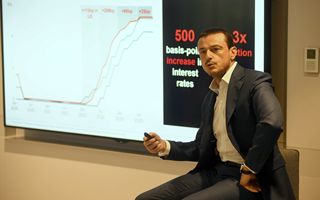(Finance) – For the Global Private Equity The 2023 represented the steepest decline since the global financial crisis, with a strong worsening in investment operations, exits and fundraising. In particular, the value and number of deals decreased by 60% and 35% respectively compared to the peaks of 2021, with a slightly better performance in the second half of the year. The value of investments in buyouts fell by 37% year on year, reaching 438 billion euros, the worst value since 2016. The value of exits also contracted by 66%. This is what emerges from Bain & Company 15th Annual Global Private Equity Report., which suggests a “cautious optimism” for the current year, thanks to some positive signs that are emerging.
“The scale and speed of rate rises last year, and the uncertainty of the macro environment, represented a shock for the sector in 2023 – he explains Roberto Fiorello, Senior Partner and Italian manager Bain & Company Private Equity – However, the long-term outlook for the industry remains strong, and – with rates set to recalibrate in the coming months – there is a greater backdrop of stability. Liquidity levels are very high, and although key challenges persist, the flow of operations is strengthening“.
Europe
In 2023, there was a significant contraction in the values of operations and exits from the Old Continent compared to 2022. The decline was recorded on deals of all sizes, with large operations – those above 2.5 billion dollars – contracting more rapidly than the others.
In Europe, last year, one was recorded decrease in multiples, which has yet to fully offset the increase in interest rates. European liquidity reached approximately $821 billion in 2023, an 18% increase from the five-year average. European buyout activity fell by around 46%, the worst year since 2016. The top 10 largest buyout investments in Europe in 2023 had a combined value of around $64 billion and were made by a diverse range of buyers, two of which are in Italy.
Italy
In Italy, the slowdown recorded in 2023, in terms of both the number and value of transactions – 53% less buyouts compared to 2022 – is mainly due to unfavorable macroeconomic conditions, in line with the global trend. The good performance recorded between 2012 and 2022 clearly shows the evolution of our country towards a more mature market than in the past. At a local level, we see a more homogeneous distribution of operations by sector compared to the rest of Europe, in line with the Italian economic ecosystem. The share of the technology sector is growing, although still behind European levels.
“The macroeconomic turbulence that characterized last year – inflation, geopolitics, interest rates – have not yet been resolved – adds Fiorello – They will probably continue to influence investment positions, also in Italy, at least in the first half of the year. However, the flow of operations is strengthening in the country: several assets (especially for the mid-cap segment) are approaching exits in 2024also by virtue of some trials delayed from 2023″.
Exit and IPO
The exit dilemma has emerged as the most pressing issue for general partners (GPs), pushing them to find creative ways to create liquidity for their investors. According to Bain & Company, lack of predictability is something we’ve always seen, but this exit impasse and rising interest rates are entirely new themes.
The sponsor-to-sponsor releases they were particularly impacted: These deals have fallen 47% since 2022 to $62 billion, with private equity buyers discouraged by higher rates. Meanwhile, the IPO channel – despite representing just 3% of total exit volume – has shown some signs of recovery, at $11.8 billion last year.
GenAI and secondary funds
According to Bain & Company, two phenomena are affecting the world of Private Equity, with a significant impact on the evolution of the industry. One year after the explosive advent of GenAI, it has become increasingly clear how these technologies are revolutionizing all industries, including Private Equity, with implications at every level of the value chain. In particular, i funds are using GenAI as a tool at the service of strategy and portfolio improvement, but also as a technology useful for rethinking due diligence, developing scorecard-based protocols to evaluate threats and opportunities related to generative AI and to accelerate and refine the underwriting process. Finally, GenAI offers several opportunities to streamline or automate back-office functions. Not only that: the true power of this technology lies in its ability to drastically expand the field of information that companies use to make investment decisions.
There are other protagonists at the center of the scene of Private Equity activity in 2023: these are the secondary funds. In light of the industry’s liquidity crisis, they grew faster than any other asset class, raising 92% more capital in 2023 than the previous year. Although still relatively small in size, in light of the need for liquidity solutions in private capital, this asset class is growing rapidly, with a wide range of tools that limited partners and general partners can use to manage increasingly complex needs of their stakeholders.
Their usefulness is measured by unrealized backlog (or value). by funds, represented by the 28,000 unsold companies that weigh on buyout portfolios globally, more than 40% of which are at least four years old. This backlog, $3.2 trillion, is up very high levels: Its value is four times the level of the global financial crisis of 2007-2008. For large investors – such as sovereign wealth funds – the returns and flexibility offered by secondaries will become increasingly attractive. The same could be true for large investment houses, which manage significant wealth on behalf of individuals eager to access alternative classes.
